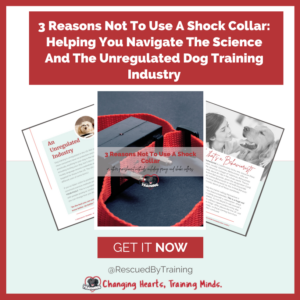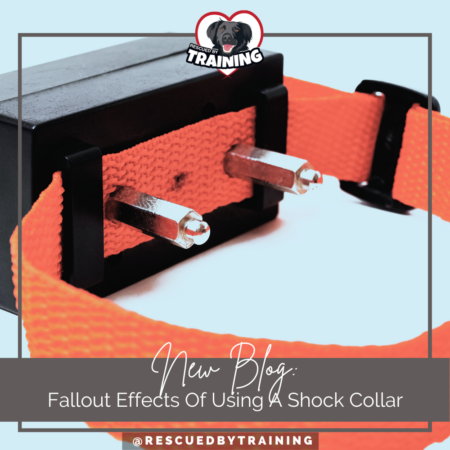 I’ve previously written about 5 Myths About Shock Collars and have my free download 3 Reasons Not To Use A Shock Collar. I talk more about why not to use these tools, take a deeper dive into regulation and give you citations to research if you’d like to look at it for yourself. You can also check out the Shock Free Coalition and sign the pledge to never use shock.
I’ve previously written about 5 Myths About Shock Collars and have my free download 3 Reasons Not To Use A Shock Collar. I talk more about why not to use these tools, take a deeper dive into regulation and give you citations to research if you’d like to look at it for yourself. You can also check out the Shock Free Coalition and sign the pledge to never use shock.
But today I want to talk a little about the fallout effects of using shock. Many clients tell me, almost proudly or to somehow justify their use, that their dog “only needed to be shocked twice and then they stopped barking” or “only needed two shocks from the fence and now they respect the boundary of the property.”
And maybe that’s true. But in the process, the dog has been traumatized. They’re living in fear or pain. Or unsure of when the pain will happen and the dog shuts down.
There are absolutely fallout effects from using punitive and painful training methods, even if it looks like it only took one of two times for it to “work.” Electric fence and shock collar manufacturers or sales people will not tell you about the fallout effects of using these products but I see it in my practice time after time.
What are the possible fallout effects from using a shock collar, bark collar or electric fence?
- increased aggression or fear towards people
- increased reactivity towards dogs
- lost dogs because the dog busted through the “invisible” fence, often chasing wildlife and then never returns
- fear of going outside
- learned helplessness where the dog just shuts down in different situations
- suppression of warning signs and communication
- long lasting stress effects, beyond the use of the collar
And we know there are better, more effective and more humane ways to train dogs. Many countries in the world ban the use of shock (and in some cases, prong collars also). Austria, Denmark, Germany, Norway, Portugal, Slovenia, Sweden, Switzerland, Wales, some parts of Australia, and the province of Quebec in Canada yet in the US, it’s still completely legal. There is a recent legislation being proposed in NY but widely in the US, shock collars are legal. In 2020 Petco became the first large scale retailer to stop selling remote controlled shock collars but still sells electric fence and containment systems.
There’s a lot of research on this topic, but a study published in the Journal of Veterinary Behavior, concluded “there is no credible scientific evidence to justify electronic collar use and the use of spray collars or electronic fences for dogs.” This study looked at the top 3 ways dogs are shocked in the name of training – remote controlled shock collars, anti-bark collars and electric fence/containment systems.
Learning shouldn’t hurt.
So why do people turn to shock collars? The study gathered responses, many of which I’ve seen in my own practice. Some of these include, people turn to these methods because it looks like it is a quick fix, they think it’s cheaper than hiring a qualified trainer, they feel the ends justify the means, they tried it on themselves and “it didn’t hurt that much” or they just don’t know better.
And this brings me to a critical point, at least here in the US, which I have mentioned before. Professional licensure is not required to call yourself a dog trainer in the US. You need more licensing to cut someone’s hair than you do to train a dog. Professional licensure is not required to call yourself a dog trainer in the US. Not only does this mean consumers have no protection and anyone can do practically anything to your dog in the name of training, including hurting your dog, but it also means there’s a lot of muddy language around credentials and titles. Demand transparency and ask questions. There’s also recent legal filing against one of the manufacturers of a popular shock collar alleging they’re falsely marketed as safe.
If you’ve fallen victim to predatory training methods or were convinced aversive methods are the solution, IT IS NOT YOUR FAULT. This is a symptom of an unregulated industry, with people posing as “professionals” with no recourse. But, you can change how you do things NOW.
“Do the best you can until you know better. Then when you know better, do better.” – Maya Angelou
So while some people turn to things like shock collars, thinking they will save money, we know from other research that aversive methods can (and often do) result in increased fear, aggression, or learned helplessness, and fixing those long-term issues properly will cost you more money in the long-run, not to mention the emotional cost to your dog and the damage to your relationship with him.
For more about this topic, you can read these other posts where I’ve addressed the topic of Behavior Suppression Isn’t Behavior Modification, Fear Is Not Disobedience and that dogs very rarely “bite out of nowhere.” The common thread in these posts is behavior issues getting worse with punishment based methods of training.
There are better, more humane, more effective ways to get results and I can help you. Contact me and schedule a session if you need help.
Happy training!
![]()




